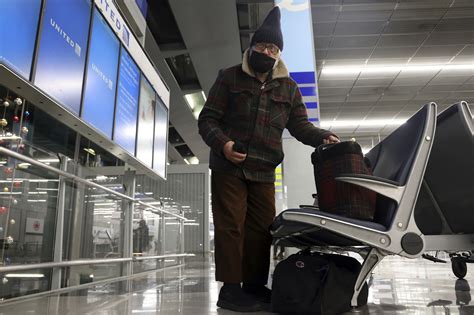
United Airlines has halted its rollout of Starlink internet service due to performance issues encountered during initial installations. Antenna problems affecting the WiFi’s reliability and speed prompted the airline to pause further installations while seeking solutions.
United Airlines has put the brakes on its plans to equip its aircraft with SpaceX’s Starlink internet service after encountering issues with the antenna installations. The airline confirmed that the rollout has been paused due to unsatisfactory performance stemming from problems with the antennas, which are crucial for delivering high-speed internet to passengers inflight. The move comes after initial enthusiasm for Starlink’s potential to provide a superior WiFi experience on domestic and potentially international routes.
“Starlink’s performance has not yet reached our expectations,” a United Airlines spokesperson said. “We are working with SpaceX to evaluate the performance and address the issues before moving forward with more installations.”
The decision to pause the rollout reflects the challenges of integrating cutting-edge technology into the complex environment of commercial aviation. While Starlink has garnered attention for its ability to deliver high-speed, low-latency internet through a network of satellites in low Earth orbit, adapting the technology for use on airplanes presents unique hurdles, including ensuring stable connectivity during flight maneuvers, managing interference with aircraft systems, and meeting stringent safety and regulatory requirements.
The initial announcement of the partnership between United Airlines and Starlink generated considerable excitement among travelers who have long lamented the inconsistent and often expensive WiFi options available on many flights. Starlink promised to deliver a game-changing connectivity experience, enabling passengers to stream videos, conduct video conferences, and engage in other bandwidth-intensive activities without the frustrating lag and interruptions that are common with traditional air-to-ground internet systems.
However, the reality of implementing the technology has proven more complex. The antenna issues encountered by United Airlines underscore the importance of rigorous testing and careful integration when introducing new technologies into the aviation sector. The antennas are a critical component of the Starlink system, responsible for receiving and transmitting signals to and from the satellites. Any malfunction or degradation in antenna performance can significantly impact the quality and reliability of the internet service.
The specific nature of the antenna problems has not been disclosed in detail, but industry experts speculate that potential issues could include:
- Aerodynamic Effects: Antennas mounted on the exterior of an aircraft are subjected to intense aerodynamic forces during flight, which can cause vibrations, stress, and potential damage. Ensuring that the antennas are robust enough to withstand these forces without compromising performance is a significant engineering challenge.
- Interference: Aircraft operate in a complex electromagnetic environment, with numerous onboard systems emitting and receiving radio waves. Interference between the Starlink antennas and these other systems could degrade the performance of the internet service.
- Signal Acquisition and Tracking: Maintaining a stable connection to the Starlink satellites requires precise antenna pointing and tracking. Any deviation from the optimal alignment can result in signal loss and reduced bandwidth.
- Environmental Factors: The antennas must be able to withstand extreme temperatures, humidity, and other environmental factors encountered during flight. These conditions can potentially affect the performance and longevity of the antennas.
- Installation Issues: The physical installation of the antennas on the aircraft is a delicate process that must be performed with meticulous care. Improper installation can lead to misalignment, damage, or other issues that can compromise antenna performance.
United Airlines is not the only airline to explore the potential of Starlink internet. Several other carriers, including Hawaiian Airlines and JSX, have also announced partnerships with SpaceX to offer Starlink service on their flights. However, United’s decision to pause its rollout underscores the challenges and complexities involved in bringing this technology to the aviation market.
For passengers, the delay in the rollout of Starlink on United Airlines flights is undoubtedly disappointing. Many travelers were looking forward to the prospect of a faster, more reliable, and more affordable internet experience in the air. The current WiFi options on many flights are often slow, expensive, and unreliable, making it difficult for passengers to stay connected and productive during their travels.
The pause in the Starlink rollout also raises questions about the future of inflight internet connectivity. While Starlink holds considerable promise, it is not the only technology being explored for providing internet service on airplanes. Other options include:
- Air-to-Ground (ATG) Systems: These systems use a network of ground-based towers to transmit internet signals to antennas on the aircraft. ATG systems have been used for many years and are relatively mature, but they typically offer lower bandwidth and higher latency compared to satellite-based systems like Starlink.
- Ku-Band Satellite Systems: These systems use satellites in geostationary orbit to provide internet connectivity. Ku-band systems are widely used on international flights, but they can be affected by weather conditions and may not offer the same level of performance as Starlink.
- Ka-Band Satellite Systems: These systems use satellites in geostationary orbit to provide internet connectivity. Ka-band systems offer higher bandwidth than Ku-band systems, but they are also more susceptible to weather-related disruptions.
Each of these technologies has its own strengths and weaknesses, and the optimal solution for a particular airline will depend on a variety of factors, including the routes flown, the type of aircraft used, and the needs and expectations of passengers.
United Airlines’ decision to pause its Starlink rollout highlights the need for careful evaluation and testing of new technologies before they are deployed on a large scale. While Starlink has the potential to revolutionize inflight internet connectivity, it is essential to address the technical challenges and ensure that the system meets the stringent requirements of the aviation industry.
The airline stated that it remains committed to improving the inflight internet experience for its passengers and is actively working with SpaceX to resolve the antenna issues and move forward with the Starlink rollout as soon as possible. The timeline for resuming installations is currently uncertain, but United Airlines has pledged to provide updates as more information becomes available. The company emphasized its dedication to innovation and providing passengers with the best possible travel experience.
The setback for United Airlines also underscores the broader challenges of deploying satellite internet services. While companies like Starlink and OneWeb have made significant strides in launching large constellations of satellites, providing reliable and affordable internet access to customers around the world is a complex undertaking that requires overcoming a range of technical, regulatory, and economic hurdles.
The future of inflight internet connectivity remains uncertain, but one thing is clear: Passengers are increasingly demanding a better online experience when they fly. Airlines that can deliver fast, reliable, and affordable internet service will have a significant competitive advantage in the years to come. United’s journey with Starlink, despite the current pause, is a testament to the ongoing pursuit of this goal.
The airline’s proactive approach in addressing the antenna issues reflects a commitment to ensuring that the technology meets its operational and customer service standards. This cautious approach, while temporarily delaying the rollout, is aimed at ultimately providing a superior and more reliable inflight internet experience for United Airlines passengers.
Industry analysts suggest that the challenges faced by United Airlines with the Starlink antenna installations are not uncommon in the early stages of adopting new technologies. The integration of satellite-based internet services into aircraft involves complex engineering and logistical considerations. These include ensuring seamless connectivity, managing signal interference, and meeting stringent safety regulations.
The decision to halt the Starlink rollout also underscores the importance of thorough testing and validation before widespread deployment. Airlines need to ensure that the technology is not only capable of delivering high-speed internet but also reliable and safe for use in a demanding aviation environment.
The impact of this decision on United Airlines’ competitive position remains to be seen. While the airline may experience a temporary setback in its efforts to offer enhanced inflight internet service, its proactive approach to addressing the antenna issues could ultimately strengthen its reputation for quality and reliability. Passengers are likely to appreciate the airline’s commitment to ensuring that the technology meets their expectations before it is fully rolled out.
Moreover, the delay provides United Airlines with an opportunity to evaluate alternative inflight internet solutions and refine its overall connectivity strategy. The airline can assess the performance of other satellite-based and air-to-ground systems and make informed decisions about the best way to meet the evolving needs of its passengers.
Ultimately, the success of Starlink and other satellite-based internet services in the aviation industry will depend on the ability of technology providers and airlines to overcome the technical challenges and deliver a reliable, affordable, and seamless connectivity experience. The pause in United Airlines’ Starlink rollout serves as a reminder that innovation in the aviation sector requires careful planning, rigorous testing, and a commitment to continuous improvement.
The incident also highlights the broader trends in the aviation industry, where airlines are increasingly focused on enhancing the passenger experience through technology. Inflight internet connectivity has become a key differentiator for airlines, and passengers are willing to pay a premium for access to fast and reliable internet service.
As competition among airlines intensifies, the ability to offer a superior inflight internet experience will become even more important. Airlines that can successfully integrate new technologies like Starlink into their operations will be well-positioned to attract and retain customers in the years to come.
United Airlines’ decision to pause its Starlink rollout should not be interpreted as a rejection of the technology. Rather, it reflects a prudent approach to ensuring that the system meets the airline’s high standards for performance and reliability. The airline remains committed to working with SpaceX to resolve the antenna issues and bring the benefits of Starlink internet to its passengers as soon as possible.
The situation also serves as a reminder of the challenges and complexities involved in deploying new technologies in the aviation industry. The aviation environment is highly regulated, and airlines must adhere to strict safety and operational standards. Integrating new technologies into aircraft requires careful planning, rigorous testing, and close collaboration between airlines, technology providers, and regulatory agencies.
The pause in United Airlines’ Starlink rollout is a temporary setback, but it does not diminish the long-term potential of satellite-based internet services to revolutionize inflight connectivity. As technology continues to advance and costs continue to decline, satellite internet is likely to become an increasingly important part of the aviation landscape.
The airline reiterated its commitment to providing its passengers with a superior travel experience and stated that it will continue to explore new technologies and partnerships to enhance its inflight services. The company emphasized that the pause in the Starlink rollout is a temporary measure and that it remains optimistic about the future of inflight internet connectivity.
The current situation may also prompt other airlines considering Starlink to conduct even more extensive testing and evaluation before committing to a full-scale rollout. This could lead to a more cautious and deliberate approach to adopting the technology, but it could also result in a more reliable and seamless experience for passengers in the long run.
The challenges faced by United Airlines highlight the importance of collaboration between airlines and technology providers in the development and deployment of new inflight connectivity solutions. By working together, airlines and technology providers can address the technical challenges and ensure that the technology meets the needs of passengers and the operational requirements of airlines.
The situation also underscores the need for ongoing investment in research and development in the area of inflight connectivity. As passenger demand for internet access continues to grow, airlines will need to explore new and innovative technologies to meet their needs. This will require significant investment in research and development, as well as close collaboration between airlines, technology providers, and research institutions.
United Airlines’ experience with Starlink provides valuable lessons for other airlines considering adopting new inflight connectivity solutions. By carefully evaluating the technology, conducting rigorous testing, and working closely with technology providers, airlines can increase their chances of successfully deploying new technologies and providing their passengers with a superior inflight internet experience.
The airline stated that it is committed to providing its passengers with timely updates on the status of the Starlink rollout and that it will continue to work closely with SpaceX to resolve the antenna issues as quickly as possible. The company also emphasized that it is exploring other inflight connectivity solutions and that it will continue to invest in technologies that enhance the passenger experience.
The current situation may also lead to a more diversified approach to inflight connectivity, with airlines using a combination of satellite-based and air-to-ground systems to meet the needs of their passengers. This would provide airlines with greater flexibility and resilience, as they would not be reliant on a single technology provider.
The challenges faced by United Airlines with the Starlink antenna installations are a reminder that innovation in the aviation sector is not always a smooth process. There are often unforeseen challenges and setbacks along the way. However, by learning from these experiences and working together, airlines and technology providers can overcome these challenges and deliver the benefits of new technologies to passengers.
The airline reiterated its commitment to providing its passengers with the best possible travel experience and stated that it will continue to explore new and innovative ways to enhance its inflight services. The company emphasized that the pause in the Starlink rollout is a temporary measure and that it remains optimistic about the future of inflight connectivity.
Frequently Asked Questions (FAQ)
1. Why did United Airlines pause its Starlink rollout?
United Airlines paused the rollout of Starlink internet service due to performance issues encountered during initial installations. These issues primarily stem from problems with the antennas, which are crucial for delivering reliable and high-speed internet to passengers. According to a United Airlines spokesperson, “Starlink’s performance has not yet reached our expectations,” prompting the airline to work with SpaceX to address the problems before proceeding with further installations.
2. What specific problems were encountered with the Starlink antennas?
While the specific nature of the antenna problems has not been explicitly detailed, industry experts speculate potential issues could include aerodynamic effects on the antennas during flight, interference with other aircraft systems, challenges in maintaining stable signal acquisition and tracking with the satellites, environmental factors affecting antenna performance, and potential issues related to the physical installation of the antennas on the aircraft. These factors can contribute to degraded performance and reliability of the internet service.
3. What are the alternatives to Starlink for inflight internet connectivity?
Several alternatives to Starlink exist for providing inflight internet connectivity, each with its own strengths and weaknesses. These include:
- Air-to-Ground (ATG) Systems: These systems use a network of ground-based towers to transmit internet signals to antennas on the aircraft. While relatively mature, they typically offer lower bandwidth and higher latency compared to satellite-based systems.
- Ku-Band Satellite Systems: These systems use satellites in geostationary orbit. Widely used on international flights, they can be affected by weather conditions and may not offer the same performance level as Starlink.
- Ka-Band Satellite Systems: Similar to Ku-band systems, but offer higher bandwidth, though are also more susceptible to weather-related disruptions.
4. What is the timeline for United Airlines to resume the Starlink rollout?
The timeline for resuming installations is currently uncertain. United Airlines has stated that it will provide updates as more information becomes available and as it works with SpaceX to resolve the antenna issues. The airline remains committed to improving the inflight internet experience for its passengers and is actively working to move forward with the Starlink rollout as soon as possible.
5. Will the pause in Starlink rollout affect other airlines using or planning to use Starlink?
The pause in United Airlines’ Starlink rollout could prompt other airlines considering Starlink to conduct more extensive testing and evaluation before committing to a full-scale rollout. This could lead to a more cautious approach to adopting the technology across the aviation industry, potentially resulting in a more reliable and seamless experience for passengers in the long run as issues are addressed proactively. It emphasizes the importance of thorough testing and validation before widespread deployment in the demanding aviation environment.









